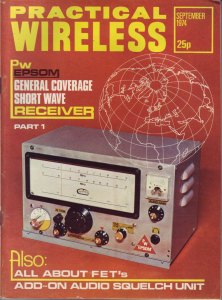As you may have gathered by now, I’m quite keen on homebrew equipment…I don’t mind whether it’s valve or solid state; I do however avoid SMD projects if I can. One of my main interests is valve (or ‘tube’ if you live across the pond) receivers. There are quite a few to choose from including the famous G2DAF and G3PDM designs. Many of the designs that have appeared in Practical Wireless (PW) and RadCom over the years are fairly basic and may struggle on today’s crowded bands. This is fine if you are building a direct conversion or regenerative set as they have a charm all of their own. The problem is that many of the ‘advanced’ projects had drifty VFO’s and poor selectivity…OK for AM but not for SSB and CW. I did recently come across a PW design from 1974 which looks interesting enough to accumulate the bits to build.
It’s called the PW Epsom and was featured in the September and October 1974 editions of PW…I’ve scanned the articles in to a PDF available on my ‘downloads’ page. The Epsom was designed by Eric Dowdeswell G4AR, who I remember used to run the ‘Amateur Bands’ column in PW all those years ago.
Eric’s design uses a nice Eddystone 898 dial in quite a compact cabinet, with a separate outboard power supply and speaker. The Epsom is a hybrid design using valves for the RF/IF sections and solid state devices for the detector and audio stages. Component count is relatively low although you will have to source some crystals and the ubiquitous Denco coils.
Eric says in his article that the receiver is stable and I see no reason to doubt this. The main features I want to investigate are:
- The performance of the 6JH8 mixer. There is no RF stage which is a great idea (used by G3PDM too) for minimising cross modulation and other overload effects, if you have a low noise mixer such as the 6JH8 beam deflection design.
- How well a simple half lattice crystal filter performs on today’s bands.
- The Epsom uses just two EF183 IF stages, whereas G3PDM used three after his 7360 mixer. Is there really enough gain? Hopefully there will be as the EF183 is a brilliant IF amplifier valve.
There are a few things I might change, but only after testing the original design first:
- The product detector is a bit basic…I may fit a further valve to do the job properly, but we’ll see.
- There’s no AGC on SSB or CW. OK, there’s a manual RF gain control but I’d like to see an effective AGC circuit as it can transform a receiver.
- Eric used an LM380 audio IC…argh! Yes, they work, but LM380’s are probably the noisiest IC amplifier on the planet…not to mention the distortion. I suspect this will be replaced very quickly…maybe with a nice ECL83 😉
So, another one for the project pot…once I’ve worked my way through some others.
